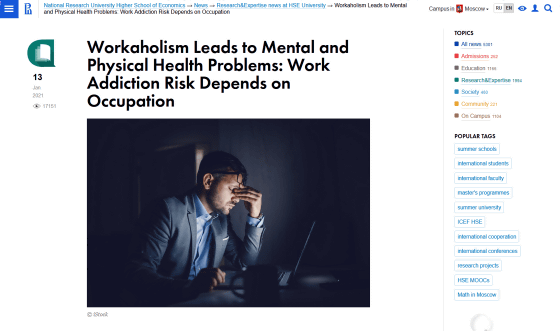What kind of work are workers likely to be 'workaholics'?

There are people in the world called
Exploring the Link between Work Addiction Risk and Health-Related Outcomes Using Job-Demand-Control Model
https://www.ncbi.nlm.nih.gov/pmc/articles/PMC7593928/
Workaholism Leads to Mental and Physical Health Problems: Work Addiction Risk Depends on Occupation — HSE University
https://www.hse.ru/en/news/research/433782660.html

Workaholics are distinguished from others by their high working hours, but they are financially distressed and forced to work long hours, or are forced to work long hours by pressure from an organization or boss. If so, it is not considered workaholic. In terms of public health, it is considered workaholic when 'you don't need long hours of work and you work excessively when others don't expect it.'
The research team conducted a survey of 187 French workers, what kind of work each subject is engaged in, how high the risk of workaholics is, and what kind of mental and health effects they have. I investigated whether it was out.

The research team analyzed the work of workers based on the ' Karacek Workplace Stress Model (Karacek Model) ' proposed by Swedish scholar Robert Karasek . Mr. Karasek analyzes stress in the workplace from two axes: 'work demand', which represents the degree of concentration and tension required for work, and 'work discretion', which represents discretion and autonomy in work. We classify work into four types. The model of work shown in the Karasek model is as follows.
・ Passive work
Jobs with low discretion and low demand for work. If a worker reaches a set goal, it is likely to be satisfied.
・ Low tension work
Jobs with a high degree of discretion and low demand for work. In general, it is often a creative job and has little impact on mental health.
・ Active work
Jobs with a high degree of discretion and high demands for work. Workers serve as executives of companies and specialists in important positions, and have high responsibilities and high skills. Although he is doing a very tough job, he has a high degree of freedom in decision-making in problem solving.
・ High tension work
Jobs with low discretion and high demand for work. Workers, such as medical workers in the emergency department, are in a situation where they cannot control the work load by themselves, and are said to be stressful.
Questionnaires include questions based on the Karasek model, such as 'job requirements,' 'work discretion,' and 'social support available,' questions that measure the likelihood of becoming a worker holic, and symptoms of anxiety and depression. Questions included questions about socio-demographic points such as age, gender, education level, family structure, physical activity, and amount of sleep.

Analysis of the results of the questionnaire revealed that 45.5% of the subjects were judged to have a low risk of workaholics, 32.6% had a medium risk, and 21.9% had a high risk. As a result of investigating the relationship between workaholic risk and work demand and discretion, it was also found that 'the higher the job demand, the higher the risk of workaholic, while the discretion of work has nothing to do with the risk of workaholic'. That is.
Workers with high job demands are five times more likely to be workaholics than workers with low job demands, and the proportion of workers at high risk of workaholics who have reached dangerous levels of depression risk It seems that there were twice as many. In addition, the quality of sleep, well-being, and stress at work were also worse for workers at high risk of workaholics, confirming that workaholics put a heavy burden on the mind and body.
'One of the novelties in this study was to inform organizations and employers of dangerous occupational groups,' said Morteza Charkhabi, an assistant professor at the Higher School of Economics , Russian National Research University , who was involved in the study . By finding certain occupations that are at high risk for workaholics, he says, he can intervene before they adversely affect his health.

Related Posts:
in Note, Posted by log1h_ik







